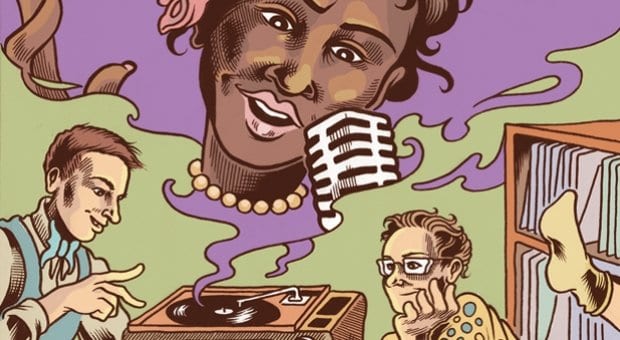A young woman named Eleanora Fagan first heard Bessie Smith’s music in the parlour of a whorehouse. In Fagan’s autobiography, she explains that although she was picky about who she’d run errands for in her Baltimore neighbourhood, she would do anything for the brothel owner and her girls. “When it came time to pay me, I used to tell [the owner] she could keep the money if she’d let me come up in her front parlor and listen to Louis Armstrong and Bessie Smith on her victrola.”
Smith was born in April 1894 in Chattanooga, Tennessee. By the time she was eight she was an orphan being raised by her older sister. From the age of nine until she was 18, she sang on Ninth Street in Chattanooga, then was taken on as a dancer in a travelling show. She was dropped as a chorus girl because she was “too black,” but this didn’t deter her. After getting her start at Atlanta’s 81 Theater, a vaudeville club that was her home base in the early years, she became one of the big names of blues “race” records, a term applied to all recordings by black performers, considered a novelty until the industry realized how popular blues was with white customers.
In 1922 Smith met John “Jack” Gee, an illiterate night watchman, and they married a few years later. The abusive relationship continued even after Smith became famous, and secret affairs were common. Smith enjoyed prolonged affairs with both men and women, though she preferred lovers with darker complexions. Violent fights between her and Gee were frequent; during one tour, Smith heard a rumour that her husband had slept with a chorus girl, and she found his gun and chased him away.
During that holiday season, in 1926, Smith took up with a chorine named Lillian Simpson. Shortly after the New Year, Smith tried to kiss Simpson in front of Smith’s niece, chorus girl and confidant Ruby Walker. Simpson pulled away, embarrassed, angering Smith, who spat, “I got 12 women on this show and I can have one every night if I want it. Don’t you feel so important, and don’t you say another word to me while you’re on this show or I’ll send you home bag and baggage.” After a few days of being ignored, Simpson attempted to kill herself, barricading herself in a hotel room and filling the room with gas. Handed the suicide note after her show, Smith rushed to the hotel room and broke in, saving Simpson. The chorine was less ashamed of the relationship after that, though she eventually ran away from the tour, out of fear of Smith’s husband.
The night after Simpson left, Smith took a few of the showgirls out to a local “buffet flat” in Detroit. These establishments, sometimes called good-time flats, were privately owned clubs that often featured gambling, sex shows and live sex, catering to regular clients and thrill seekers. As Walker remembers, “It was nothing but faggots and bulldykers, a real open house. Everything went on in that house — tongue baths, you name it. They called them buffet flats because buffet means everything, everything that was in the life. Bessie was well known in that place.” The buffet flat’s main attraction was a young man making expert love to another, but Smith was apparently mesmerized by an obese woman who performed a trick featuring her vagina and a lighted cigarette, then repeated the trick with a Coca-Cola bottle. As a true Southerner, Smith had always been a big fan of Coke.
A closing-night tradition for Smith and her pyjama-clad girls was to drink, eat Smith’s cooking and talk into the wee hours at their hotel. Unfortunately, Gee had the habit of showing up at the worst time, which included finding Smith in bed with one of the girls after a party. Everyone was justifiably afraid of him, especially Smith, whom he threatened to kill. Everyone managed to hide until Gee had left the hotel, then they packed up and left town before he could track Smith down.
Eleanora Fagan would eventually change her name to Billie Holiday. Like many other artists of the 20th century, she named Smith as one of her major influences. Interestingly enough, three days after Smith, known as the Empress of the Blues, made her last recording of “Down in the Dumps,” at an Okeh-Columbia Records studio in 1933, an 18-year-old Holiday, who became known as Lady Day, made her first recording in the same studio, her first step on the path to becoming musical royalty.


 Why you can trust Xtra
Why you can trust Xtra


